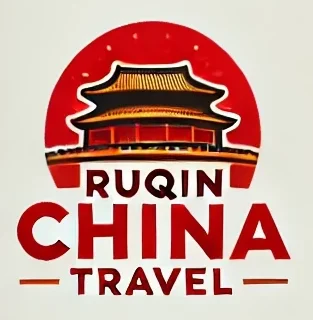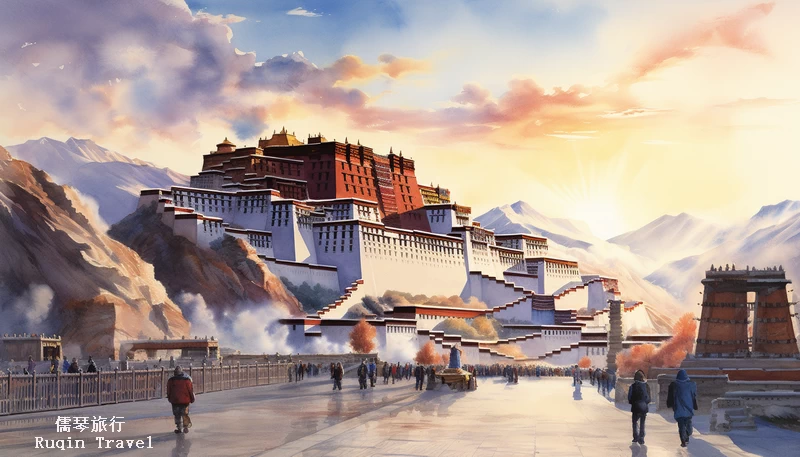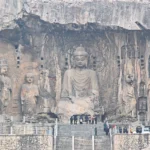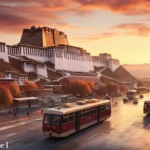Lhasa is where Tibetan Buddhism, ancient culture, and breathtaking landscapes meet. It’s home to iconic sites like the Potala Palace, Jokhang Temple, and many hidden treasures waiting to be explored. However, as a first-time foreign visitor, you might wonder: how to book Lhasa attraction tickets ? Where should I start?
Don’t worry—this guide has you covered. We’ll show you exactly how to book Lhasa attraction tickets, give you tips on when and where to visit, and explain how to make the most of your time at high altitude. From paid highlights to lesser-known free spots, and from booking hacks to travel planning tips, this is your one-stop guide to exploring Lhasa with ease.
Let’s get started and make your Lhasa journey unforgettable!
1. Lhasa Travel Overview: First Impressions of the Sacred City
Lhasa, meaning “Land of the Gods” in Tibetan, is a 1,300-year-old city rich in history and spirituality. In the 7th century, King Songtsen Gampo unified Tibet and made Lhasa his capital. He built the Potala Palace and Jokhang Temple, laying the foundation for Lhasa’s sacred status.
Today, the city offers a fascinating mix of old and new. You’ll see pilgrims spinning prayer wheels next to modern cafés, and ancient monasteries standing beside high-end hotels. This blend creates a truly unique atmosphere you won’t find anywhere else.
👉 Book your All Lhasa Tours & Excursions with local guides via Viator — an unforgettable, immersive experience
For foreign travelers, the true charm of Lhasa lies in its vibrant Tibetan culture and stunning landscapes. The golden roofs of the Potala Palace shine brightly under the sun. In front of Jokhang Temple, devoted worshippers prostrate for hours. Meanwhile, the nearby Barkhor Street bursts with Tibetan handicrafts. If you venture farther out, holy lakes like Namtso and Yamdrok reveal the pure, untouched beauty of the plateau.
Lhasa’s travel seasons fall into two main categories. High season runs from May to October with pleasant weather, but large crowds and tight ticket availability. Low season (November to April) offers fewer tourists, and many A-rated scenic areas (excluding temples) are free to visit—such as during October 15, 2024, to March 15, 2025. However, some sites may close due to snow or cold.
So no matter when you go, it’s essential to plan early and know how to book Lhasa attraction tickets. This will help you enjoy a smooth and unforgettable experience in this extraordinary city.
2.How to Book Lhasa Attraction Tickets: What Foreign Tourists Must Know
Due to Tibet’s special tourism policies, foreign travelers (including visitors from Hong Kong, Macau, and Taiwan) must join an organized tour through a licensed travel agency to enter Lhasa. This includes obtaining a Tibet Travel Permit in advance. In addition, the ticket booking process for foreigners differs significantly from that of domestic tourists.
1. ✅ Booking Channels
- Through a Travel Agency (Highly Recommended)
Foreign visitors cannot travel independently in Tibet. A travel agency must arrange your itinerary, guide, and attraction tickets.
Most agencies will book Potala Palace, Jokhang Temple, and other major attractions as part of your tour package.
Some sites like Namtso Lake and Yamdrok Lake require extra eco-vehicle fees, which your agency can help arrange. - ❌ Limited Self-Booking Options
Technically, some scenic sites (like Potala Palace or Jokhang Temple) offer WeChat or website booking. However, foreign travelers often face these issues:- You’ll need a mainland Chinese phone number to receive booking codes.
- Most booking sites don’t accept foreign payment methods.
- Even if you manage to book, you still must enter with a licensed guide—solo entry is not allowed.
- ✅ Workaround: Ask Your Agency
If you want to visit a specific place not included in the tour, discuss it with your agency. They can often help book it separately within regulations.
2. 💳 Payment Methods
- Travel Agencies Usually Prepay Tickets
Most entry fees are already included in your tour cost, so you won’t need to pay separately. - Cash (RMB): Some temples like Sera Monastery or Ganden Monastery allow on-site ticket purchase, but a guide is still required.
- International Cards: Only a few top hotels or agencies accept Visa/MasterCard. Attractions do not. Tip: Exchange currency in advance, or let your agency handle payments to avoid issues.
3. 📌 Important Things to Know
- Real-Name Booking: All attractions require real-name booking with your passport. Your agency must submit your info in advance.
At the entrance, you’ll need to show your original passport and be with your guide. - Daily Visitor Limits:
- Potala Palace has strict daily caps. Tickets must be reserved 1–7 days ahead, especially in peak season (May–October).
- Jokhang Temple limits to 2,000 visitors/day, so early booking is a must.
- Winter Free Entry Policy:
From October 15 to March 15, many attractions (e.g., Potala Palace, Norbulingka) offer free entry, but you still must book through your agency.
Some monasteries are free for Tibetan pilgrims but still charge foreign tourists. - Exclusive Entry Lines for Foreigners:
At popular sites like Potala Palace and Jokhang Temple, there are separate foreigner entry lanes—a nice perk, but access is only allowed with a guide.
4. ✔ Practical Tips
- Confirm major attraction tickets (like Potala Palace) at least one week in advance with your agency.
- Always carry passport and Tibet Travel Permit copies, especially for sites like Namtso where checks are strict.
- Avoid booking independently—even if a platform shows availability, policy restrictions might still block your entry without agency support.
🔍 Summary: What You Need to Know
- Foreign tourists must book through a travel agency—independent travel isn’t allowed.
- Self-booking isn’t practical due to ID, payment, and guide requirements.
- During the Tibet winter tourism season, some sites are free but still require agency booking.
- Book Potala Palace and Jokhang Temple early to avoid missing out.
If you have special interests or want to add sites to your plan, just talk with your travel agency ahead of time. The more you prepare, the smoother your journey will be.
4. Sample Lhasa Itineraries for Foreign Visitors
Planning your trip in Lhasa is easier when you have a flexible itinerary. Below are sample schedules based on the number of days you have. Whether you’re in Lhasa for one, two, or three days, these plans help you see the best of the city while staying within Tibet’s travel regulations.
🗓️ 1-Day Highlights Tour
Morning:
Start your day with a visit to the Potala Palace. This iconic landmark requires advance booking and offers stunning views of Lhasa from its golden rooftops. Most guided tours last about 2–3 hours.
Lunch:
Next, enjoy a Tibetan-style lunch along Barkhor Street. A popular spot is Makye Ame Restaurant, known for its traditional décor and rooftop views.
Afternoon:
Head to the Jokhang Temple, Tibet’s spiritual heart. After that, take a slow walk along the Barkhor kora path, where pilgrims walk in prayer. If time allows, continue to the Tibet Museum, where exhibits give great insight into local culture and history.
Evening:
Wrap up your day with a visit to Potala Palace Square. The illuminated palace at night is truly magical and perfect for photos.
🗓️ 2-Day In-Depth Experience
Day 1:
Morning: Explore the Potala Palace with your guide.
Lunch: Try more Tibetan dishes, such as tsampa and yak butter tea.
Afternoon: Visit the Jokhang Temple, followed by shopping for Tibetan crafts in Barkhor Street.
Evening: Watch the stunning “Princess Wencheng” outdoor drama (seasonal, usually from May to October). The show tells the story of a Chinese princess who married a Tibetan king, blending history, music, and dance in a mountain setting.
Day 2:
Option 1: Take a day trip to Namtso Lake, one of Tibet’s sacred lakes. It’s a long day (depart early, return late), but the views of turquoise waters and snow-capped mountains are unforgettable.
Option 2: Stay in Lhasa and visit the Norbulingka Summer Palace in the morning, followed by the Sera Monastery in the afternoon. Be sure to catch the famous debating monks at 3:00 PM, a unique Tibetan tradition.
🗓️ 3-Day Panoramic Adventure
Day 1:
Follow the 1-day highlights itinerary to cover the must-sees in Lhasa.
Day 2:
Take the full-day excursion to Namtso Lake. This trip offers a chance to witness the vast open spaces and spiritual calm of the Tibetan plateau.
Day 3:
Option 1: In the morning, visit Drepung Monastery, the largest monastery in Tibet. In the afternoon, soak in the hot springs at Yangbajing, a relaxing way to recover from the altitude and walking.
Option 2: Choose a full-day visit to Ganden Monastery, the founding monastery of the Gelug school of Tibetan Buddhism. Its location high in the hills offers not only spiritual depth but also sweeping mountain views.
Each of these itineraries includes plenty of cultural highlights, natural beauty, and opportunities to connect with Tibetan traditions. And remember, for every stop—especially major sites like the Potala Palace—how to book Lhasa attraction tickets matters. Always coordinate early with your travel agency to ensure smooth entry and a well-paced visit.
5. Important Travel Tips for Foreign Visitors in Lhasa
Traveling to Lhasa is an unforgettable experience, but it does come with unique challenges. To help you stay safe and make the most of your journey, here are some essential tips for foreign tourists.
🧠 Altitude Awareness
Lhasa sits at an elevation of 3,650 meters, so altitude sickness is common—especially during your first 24–48 hours. Symptoms may include headache, dizziness, and insomnia.
What to do:
- On your first day, rest and avoid physical activity. Walk slowly and don’t overexert yourself.
- Drink plenty of water. Sipping butter tea can also help with adaptation.
- Avoid alcohol and heavy meals, which can worsen symptoms.
- Bring a portable oxygen canister, available in hotels and pharmacies.
📄 Passport & Permits
Foreign visitors must carry their passports at all times. To enter Tibet, you’ll also need a Tibet Travel Permit, arranged by your travel agency.
Additionally, for border areas like Everest Base Camp, you’ll need a special Border Permit. Always check in advance with your agency.
🛕 Cultural Etiquette
Tibetan culture is deeply spiritual, so respecting local customs is crucial.
Please note:
- Remove your hat before entering any monastery.
- Avoid wearing short skirts or shorts inside religious sites.
- Do not take photos of Buddha statues or prostrating pilgrims unless given permission.
- Always walk clockwise when circling stupas or temples.
- Never point at sacred objects—use an open palm facing up instead.
🧥 Weather & Clothing
Lhasa has a huge day-night temperature difference, even in summer. Be prepared for quick weather changes.
Dress smart:
- Always carry a light jacket, even during warmer months.
- The UV index is high, so bring sunscreen, sunglasses, and a hat.
- In winter (November–March), temperatures can drop below freezing. You’ll need a thick coat or down jacket.
💵 Payment & Connectivity
Most shops and restaurants in Lhasa accept cash (RMB) and mobile payments (WeChat/Alipay).
Some high-end hotels and restaurants also accept international credit cards (Visa/MasterCard).
You’ll get a stable 4G signal in urban areas, but expect weak or no service in remote places.
🩺 Health & Safety
To stay healthy during your visit:
- Avoid raw or cold food; bottled water is the safest to drink.
- Pack basic medicines like cold relief and stomach remedies.
- Respect local traditions and avoid discussing sensitive political or religious topics.
👉 Book your All Lhasa Tours & Excursions with local guides via Viator — an unforgettable, immersive experience
By following these tips and knowing how to book Lhasa attraction tickets through the proper channels, you’ll be well-prepared for a safe, respectful, and truly enriching journey to Tibet’s holy capital.
📌 Further Reading
How to Reserve Tickets in Beijing
How to Book Tickets for the Top Attractions in Xi’an
How to Book Tickets for the Top Attractions in Shanghai
How to Book Tickets for the Top Attractions in Guilin
How to Book Tickets for the Top Attractions in Suzhou
How to Book Tickets for the Top Attractions in Chengdu
How to Book Tickets for the Top Attractions in Hong Kong
How to Book Tickets for the Top Attractions in Hangzhou
How to Book Tickets for the Top Attractions in Guangzhou
How to Book Tickets for the Top Attractions in Sanya
How to Book Zhangjiajie Attraction Tickets
How to Book Huangshan Attraction Tickets
How to Book Chongqing Attraction Tickets
How to Book Kunming Attraction Tickets
How to Book Dalian Attraction Tickets
How to Book Qingdao Attraction Tickets
How to Book Shenzhen Attraction Tickets
How to Book Datong Attraction Tickets
How to Book Pingyao Attraction Tickets



